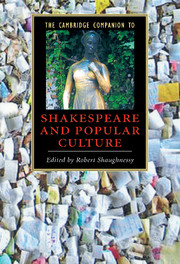Book contents
- Frontmatter
- Introduction
- 1 From popular entertainment to literature
- 2 Shakespeare abbreviated
- 3 Shakespearean stars: stagings of desire
- 4 Shakespeare illustrated
- 5 Shakespeare: myth and biographical fiction
- 6 Narration and staging in Hamlet and its afternovels
- 7 Shakespeare serialized: An Age of Kings
- 8 Musical Shakespeares: attending to Ophelia, Juliet, and Desdemona
- 9 Shakespeare overheard: performances, adaptations, and citations on radio
- 10 Shakespeare on the tourist trail
- 11 Performing Shakespeare in digital culture
- 12 Shakespeare’s popular face: from the playbill to the poster
- Further reading
- Index
- Series List
4 - Shakespeare illustrated
Published online by Cambridge University Press: 28 November 2008
- Frontmatter
- Introduction
- 1 From popular entertainment to literature
- 2 Shakespeare abbreviated
- 3 Shakespearean stars: stagings of desire
- 4 Shakespeare illustrated
- 5 Shakespeare: myth and biographical fiction
- 6 Narration and staging in Hamlet and its afternovels
- 7 Shakespeare serialized: An Age of Kings
- 8 Musical Shakespeares: attending to Ophelia, Juliet, and Desdemona
- 9 Shakespeare overheard: performances, adaptations, and citations on radio
- 10 Shakespeare on the tourist trail
- 11 Performing Shakespeare in digital culture
- 12 Shakespeare’s popular face: from the playbill to the poster
- Further reading
- Index
- Series List
Summary
The earliest illustration of a Shakespearean subject, and the only one surviving from Shakespeare's lifetime, is a drawing related to Titus Andronicus. (Figure 2) It appears on a single sheet preserved in the collection of the Marquess of Bath at Longleat; it is inscribed with the name of Henry Peacham, presumably the emblem writer and author of The Complete Gentleman, and a date that has been interpreted as either 1595 or (more persuasively) 1614/15. The picture is so well known that to reproduce it yet again would be superfluous were it not for its uniqueness as the sole visual testimony of a spectator contemporary with Shakespeare – this is where any discussion of Shakespearean illustration must begin.
The drawing shows Queen Tamora pleading with Titus for the life of her two sons, who kneel on the right, guarded by Aaron the Moor, as two soldiers watch. These are all characters in the play, and they are certainly performing a scene; but the scene is not in the play – or at least, not in any version that survives. There is a portion of the opening scene that includes all the figures depicted in the drawing, but at this point Aaron is a prisoner along with the two sons, and could not be standing over them with drawn sword. Below the drawing is a dramatic extract. It is this that identifies the drawing as relating to Shakespeare's Titus, but the passage transcribed is not simply a quotation from the play. It combines passages from two separate scenes: an exchange between Tamora and Titus from Act 1 is answered by a speech of Aaron's from Act 5 – both the scene and the text represent a conspectus or epitome of the drama.
- Type
- Chapter
- Information
- Publisher: Cambridge University PressPrint publication year: 2007
- 1
- Cited by

